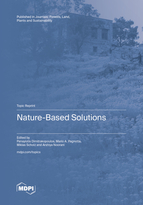Topic Menu
► Topic MenuTopic Editors



Nature-Based Solutions

A printed edition is available here.
Topic Information
Dear Colleagues,
'Nature-based solutions' (NbS) is an umbrella term for ecosystem-based approaches. It includes several actions in harmony with natural principles to achieve development goals and addressing challenges, while benefitting human livelihoods and the environment.
The NbS approach includes actions that are carried out with the collaboration of local communities, focusing on key elements such as: protection, restoration or management of ecosystems and ecosystem services; sustainable management of water systems, coastal areas, arable, grassland, and forest areas; and creation of green zones in and around urban and peri-urban areas.
In this multidisciplinary topic, studies focus on, inter alia, (a) ecosystem restoration, (b) ecosystem-based adaptation and climate change adaptation, (c) natural and green infrastructures, (d) ecosystem-based management approaches, (e) ecosystem and biodiversity conservation, (f) circular economy, and (g) the contribution of nature-based solutions to reducing the risk of future pandemics, are warmly welcome.
Prof. Dr. Panayiotis G. Dimitrakopoulos
Prof. Dr. Mario A. Pagnotta
Prof. Dr. Miklas Scholz
Dr. Arshiya Noorani
Topic Editors
Keywords
- ecosystem restoration
- ecosystem-based adaptation
- ecosystem-based management
- biodiversity conservation and management
- climate change mitigation and adaptation
- green infrastructures
- circular economy
- genetic diversity
- integrated constructed wetlands
- phytoremediation
- ecosystem services
Participating Journals
| Journal Name | Impact Factor | CiteScore | Launched Year | First Decision (median) | APC |
|---|---|---|---|---|---|

Diversity
|
2.4 | 3.1 | 2009 | 17.8 Days | CHF 2600 |

Forests
|
2.9 | 4.5 | 2010 | 16.9 Days | CHF 2600 |

Land
|
3.9 | 3.7 | 2012 | 14.8 Days | CHF 2600 |

Plants
|
4.5 | 5.4 | 2012 | 15.3 Days | CHF 2700 |

Sustainability
|
3.9 | 5.8 | 2009 | 18.8 Days | CHF 2400 |

MDPI Topics is cooperating with Preprints.org and has built a direct connection between MDPI journals and Preprints.org. Authors are encouraged to enjoy the benefits by posting a preprint at Preprints.org prior to publication:
- Immediately share your ideas ahead of publication and establish your research priority;
- Protect your idea from being stolen with this time-stamped preprint article;
- Enhance the exposure and impact of your research;
- Receive feedback from your peers in advance;
- Have it indexed in Web of Science (Preprint Citation Index), Google Scholar, Crossref, SHARE, PrePubMed, Scilit and Europe PMC.


